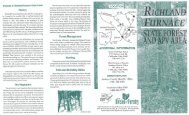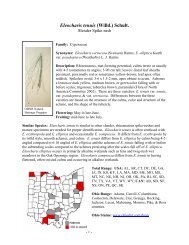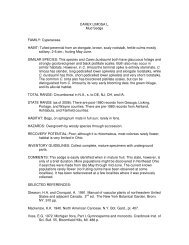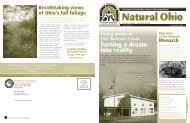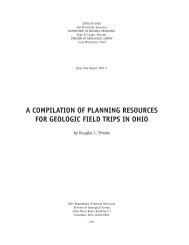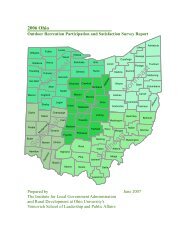Owls of Ohio - Ohio Department of Natural Resources
Owls of Ohio - Ohio Department of Natural Resources
Owls of Ohio - Ohio Department of Natural Resources
You also want an ePaper? Increase the reach of your titles
YUMPU automatically turns print PDFs into web optimized ePapers that Google loves.
likely. When one is found, a very close approach is <strong>of</strong>ten possible without unduly disturbingthe bird. They are quite tame, and particularly on sunny days, will hardly open their eyesto look at an intruder.An interesting behavior is their habit <strong>of</strong> food caching. When temperatures are very cold,owls will sometimes catch more prey than can be eaten, and stash the surplus in trees.When hungry, the owl will remove the cached item and hold it with its feet, incubating thevole or mouse like an egg and thus thawing it out so it can be consumed.Saw-whets become active and commence hunting about one-half hour after nightfall,and return to roost sites well before dawn.C O M M O N O W L S O F O H I O 37D i e t s aw -w h e t o w lAlmost entirely small mammals. Consumes lots <strong>of</strong> rodents and shrews that frequentwooded habitats, such as the white-footed mouse (Peromyscus leucopus) and short-tailedshrew (Blarina brevicauda). Saw-whets are known to capture birds when opportunitiesarise, including the Northern cardinal, winter wren, and hermit thrush.N e s ting saw -w h e t o w lNesting activities commence in April on average, preceded by an increase invocalizations. Northern saw-whet owls are cavity-nesters, and most <strong>of</strong>ten use holesconstructed by woodpeckers, particularly those <strong>of</strong> the Northern flicker and pileatedwoodpecker. They will use artificial nest boxes; one <strong>of</strong> the last <strong>Ohio</strong> nesting records was<strong>of</strong> a pair using a box. Clutches normally contain five or six eggs, laid about two daysapart. These hatch after four weeks, and the young leave the nest three or four weekslater. Recently fledged young would most likely be seen from late May into early July.Vo c aliz ati o n s s aw -w h e t o w lThe most common and easily recognized call is the male’s advertising song, a longseries <strong>of</strong> monotonous piping whistles, given at a rate <strong>of</strong> about two whistles per second.This song can be given for lengthy periods without pause. Females sometimes deliver asimilar version during the breeding season. Saw-whets have been documented utteringat least eight other types <strong>of</strong> calls, most not nearly so easily recognized as the advertisingsong. These include bill snapping, s<strong>of</strong>t whines, chitters, and ascending low screams. Some<strong>of</strong> these calls vaguely resemble calls made by sora rails.While saw-whets are unlikely to be heard here, unless one lucks into a nestingHeavily used habitat byfall migrants. This site nearChillicothe is a location wherebanders have captured upto 45 owls in less than a twomonthperiod.Banders hold a saw-whet underblack light. Feathers that appearpinkish are the newest andindicate the age <strong>of</strong> the bird.Photos by: ODNR Division <strong>of</strong> Wildlife / Jim McCormac



